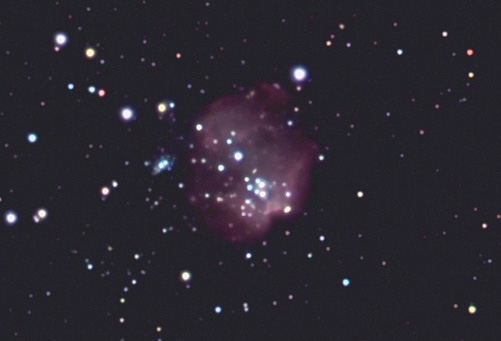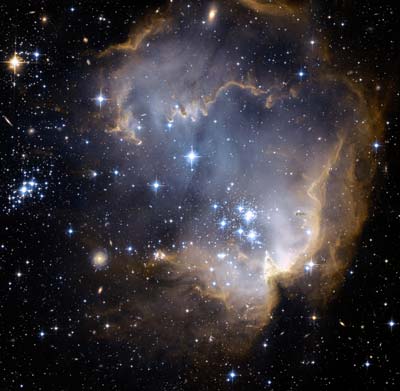|
It's the Astronomy Online non-Blog, or un-Blog.
Everyone has a blog now and since I am no follower of trends, I decided to merge the blog with the website. And I don't want to neglect the website in favor of posting on the blog.
These are the pages that were on the blog of old:
- Home
- Archive (Index of Pages)
- Me
- Current Trends
- Links
- Soho Live
Links:
Google Maps - Mars
Google Maps - Moon
HiRISE
HiRISE - MRO Imaging
Mac Singularity
Meade4M
Slackerpedia Galactica
Software for the Mac
Starry Night Online
Venus Maps
More Favorites:


































Thank you for visiting!
|
|
 |
|
Hubble Spies Young Stars in NGC 602:
On January 8, 2007, the Hubble Site released an image of NGC 602 which is a star forming region within the Small Magellanic Cloud. NGC 602 is a small open cluster with an associated nebula of left over clouds of dust and gas.
The Small Magellanic Cloud (a dwarf satellite galaxy), in the constellation Tucana, is roughly 200,000 light-years from the Earth. Its proximity to us makes it an exceptional laboratory to perform in-depth studies of star formation processes and their evolution in an environment slightly different from our own galaxy. Small dwarf galaxies are often considered the building blocks of larger galaxies. Because the number of stars are much less than a normal galaxy, star formation often lacks the heavier elements within molecular clouds in comparison to the number of generations available for study in our own galaxy.
Amateur astronomers have the ability to gather images from the Hubble Space Telescope to augment their study of personal images. For example, the image below (taken by Steven Juchnowski) shows what amateur equipment can reveal:

What is missing is the near-infrared data that would allow amateurs to image the smaller stars within the nebula. The image has been oriented to match the orientation of the Hubble image.
From July 14 to 18, 2004, NGC 602 was imaged by Hubble's ACS/WFC using F555W (V), F658N (Halpha+[N II]), and F814W (I) filters. By imaging this cluster using the near-infrared, astronomers are able to view the young stars within the cloud which would otherwise be invisible using standard RGB imaging techniques.
Astronomers assembled the original data to release the full color image to the public. The F555W (V) image served as the BLUE channel, the F555W (V) + F814W (I) images served as the GREEN channel, and the 658N (Halpha+[N II]) + F814W (I) proved the data for the RED channel - to get an RGB image.

At the heart of the cluster are a large number of small, newly born stars. These stars are hot enough to blow a cavity in the nebula making the dust cloud clear enough to see the stars within. With this image it is possible to trace how the star formation started at the center of the cluster and propagated outward, with the youngest stars still forming today along the dust ridges.
A much larger, zoomable image is available at the Hubble Site. For orientation, North is on the left and East is down.
Image Credits: Hubble Site, Steven Juchnowski
Next Post | Previous Post | Back to Top
|
|

